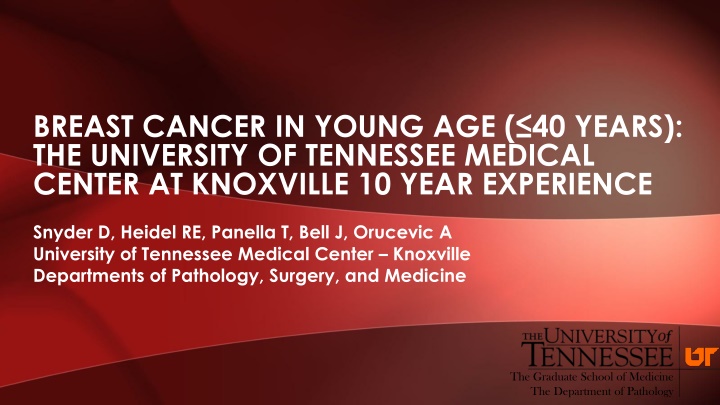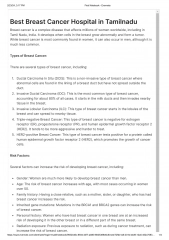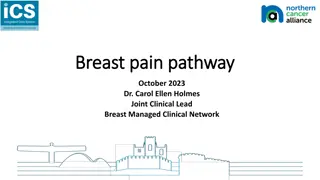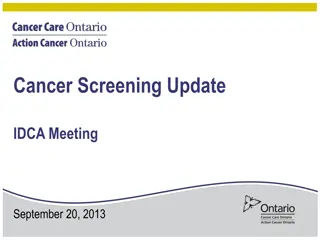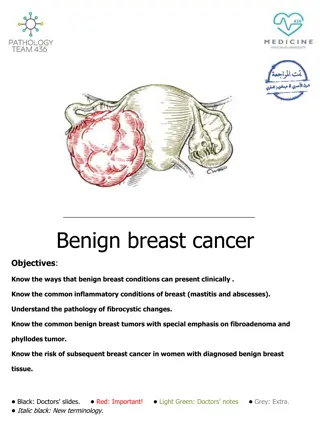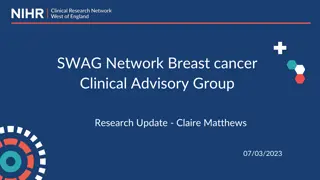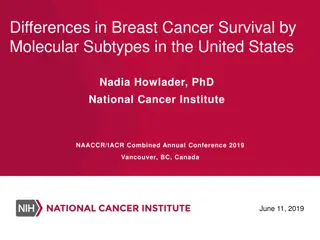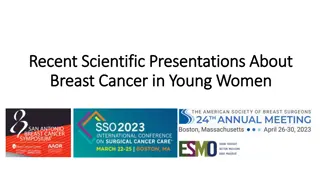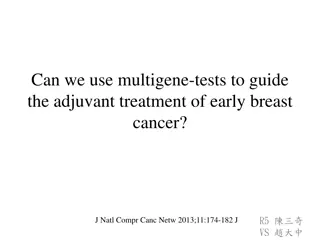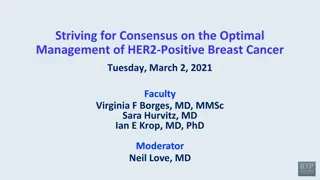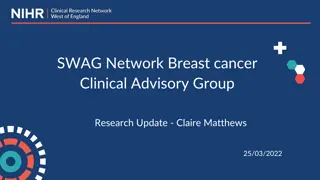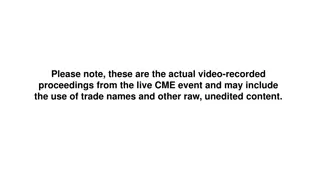Breast Cancer in Young Age: University of Tennessee Medical Center Study
Breast cancer in young women, particularly at age 40, presents unique challenges with aggressive behavior and higher mortality rates. This study from the University of Tennessee Medical Center at Knoxville over a 10-year period examines prognostic factors and overall survival in Caucasian females. The study evaluates pathologic tumor characteristics, ER/PR/HER2 subtypes, TNM stage, and therapy received, focusing on the impact on prognosis.
Download Presentation

Please find below an Image/Link to download the presentation.
The content on the website is provided AS IS for your information and personal use only. It may not be sold, licensed, or shared on other websites without obtaining consent from the author.If you encounter any issues during the download, it is possible that the publisher has removed the file from their server.
You are allowed to download the files provided on this website for personal or commercial use, subject to the condition that they are used lawfully. All files are the property of their respective owners.
The content on the website is provided AS IS for your information and personal use only. It may not be sold, licensed, or shared on other websites without obtaining consent from the author.
E N D
Presentation Transcript
BREAST CANCER IN YOUNG AGE (40 YEARS): THE UNIVERSITY OF TENNESSEE MEDICAL CENTER AT KNOXVILLE 10 YEAR EXPERIENCE Snyder D, Heidel RE, Panella T, Bell J, Orucevic A University of Tennessee Medical Center Knoxville Departments of Pathology, Surgery, and Medicine The Graduate School of Medicine The Department of Pathology
BACKGROUND Breast cancer is most common invasive cancer in women worldwide Second leading cause of death from cancer among women Approx. 11,000 cases/year in US younger than 401 5-7% of all breast cancer cases are < age 402 Breast cancer in 40y/o associated with more aggressive behavior and higher mortality than in older age.1,3 1Lee H, Han W. 2014, J Breast Cancer, 17(4): 301-307. 2Reyna C, Lee M. 2014, J Multidiscip Healthc, 7: 419-429. 3Pilewskie M, King T. 2014, J Surg Oncol, 110:8-14.
POOR PROGNOSTIC FACTORS Unfavorable ER/PR/HER2 phenotype4 Triple negative (ER-/PR-/HER2-) HER2+ (traditionally considered unfavorable , but new reports show benefit of Herceptin on overall survival)4 Young age ( 40) at time of diagnosis2,5,6 More advanced stages Higher grade tumors More lymphovascular invasion More often unfavorable phenotype Non-Caucasian race2 2Reyna C, Lee M. 2014, J Multidiscip Healthc, 7: 419-429. 4Ross, JS., et al. 2009. The Oncologist, 14(4): 320-368. 5Slamon, D., et al. 2011. N Engl J Med, 365(14): 1273-1283. 6Collins, L., et al. 2012. Breast Cancer Res Treat, 131: 1061-1066.
OBJECTIVE Young ( 40) Caucasian female patients from our institution 10 year period (1/1/1998-7/1/2008), last follow-up date 8/1/2013 Evaluated prognostic value on overall survival of: Pathologic tumor characteristics ER/PR/HER2 subtypes TNM Stage Analyzed type of therapy received
METHODS Complete data was available for 80 40 y/o Caucasian females with breast cancer Divided into five ER/PR/HER2 groups based on 2011 St. Gallen International Consensus Panel classification system7 Luminal A like group (ER+ and/or PR+, HER2-, low Ki67) Luminal B/HER2- like group (ER+ and/or PR+, HER2-, high Ki67) Luminal B/HER2+ like group (ER+ and/or PR+, HER2+) Non-luminal HER2+ like group (ER-, PR-, HER2+) Triple negative like group (ER-, PR-, HER2-) 7Goldhirsch A, et al. 2011. Ann Oncol, 22(8):1736-1747.
Favorable subtype 41% (33/80) ER+/PR+/HER2- 80 40 y/o BC patients 31% (25/80) ER+/PR+/HER2+ or ER-/PR-/HER2+ Unfavorable subtypes 28% (22/80) ER-/PR-/HER2- Distribution of patients into ER/PR/HER2 subtypes
METHODS (CONT.) Frequency statistics, Kaplan-Meier and multivariate Cox regression curves measured impact on overall survival by Pathologic tumor characteristics Effect of ER/PR/HER2 subtype TNM stage
RESULTS Majority presented with grade 3 invasive BC (67%) and TNM stage II (50%) ER+/PR+/HER2- ("favorable") 33/80 (41%) ER+/PR+/HER2+ or ER-/PR-/HER2+ ("unfavorable") 25/80 (31%) ER-/PR-/HER2- ("unfavorable") 22/80 (28%) Mastectomy (modified radical or total) 54/80 (67.9%) Breast conserving surgery 23/80 (29%) Post-surgery radiation 37/80 (46.1%) Post-surgery adjuvant chemotherapy 66/80 (82%) ER+ patients receiving hormonal therapy 37/49 (76.5%) Patients with negative lymph nodes Average number of retrieved lymph nodes 38/80 (47.5%) 12.3
RESULTS (CONT.) Kaplan Meier curve. Patients with ER+/PR+/HER2- subtype had significantly better OS than ER-/PR-/HER2- or ER+/PR+/HER2+ (p=.035) in univariate analysis
RESULTS (CONT.) Cox Regression curve. When ER/PR/HER2 subtype was controlled for TNM stage and grade in multivariate analysis, only TNM stage was a significant predictor of OS (p<.001)
SUMMARY OF RESULTS Majority of our young patients presented with high grade and Stage II breast carcinomas Treatments: Surgery: 67.9% of patients underwent mastectomy Postsurgical treatments: 46.1% received radiation therapy 82% received chemotherapy 76.5% ER+ received hormonal therapy Patients with ER+/PR+/HER2- ( favorable ) subtype had significantly better OS than ER-/PR-/HER2- (triple negative) or ER+/PR+/HER2+ (triple positive) When ER/PR/HER2 subtype was controlled for TNM stage and grade in multivariate analysis, only TNM stage was a significant predictor of OS
DISCUSSION We showed for the first time in this sub-cohort ( 40 y/o) of our Caucasian female breast carcinoma patients that unfavorable triple negative ER/PR/HER2 subtype and traditionally considered unfavorable HER2+ subtype were significant predictor of worse overall survival in univariate analysis.
DISCUSSION Other researchers: Triple-negative breast cancers were more aggressive these women had poorer survival regardless of stage Triple-negative breast cancers (most commonly) affect younger, non- Hispanic and Hispanic women in areas of low SES. 6 Bauer K., et al. Cancer. 2007;109:1721-1728.
DISCUSSION However, in multivariate analysis (controlling for TNM stage and grade), ER/PR/HER2 subtype was not significant predictor of OS, but TNM stage was significant predictor of OS. These results are in concordance with our previously published data on the effects of ER/PR/HER2 on OS8 8Ferguson, NL., et al. Breast J. 2013; 19(1)22-30.
DISCUSSION Possible causes for the differences in our findings compared to other researchers: Population differences we only studied young Caucasian females, while other studies included all ethnicities Carolina Breast Cancer Study: Triple-negative BC more common in pre- menopausal African Americans compared to non-African Americans (39% vs 16%) 9 Carey L., et al. JAMA 2006, 295:2492
DISCUSSION Other possible causes: Differences in time period of studies significant improvements in therapies over the last two decades Type of classification system used (St. Gallen vs others) Sample size
CONCLUSIONS TNM staging for breast cancer is a relevant prognostic marker in 40 y/o Caucasian females with breast carcinoma. ER/PR/HER2 status is probably relevant for prognosis, but is likely influenced by other variables. Further studies on a larger scale such as NCDB and SEER database analysis are warranted that will systematically analyze impact of race, and different ER/PR/HER2 classification systems on overall survival in this particular age group. These analyses should be performed in the same time period as our study was performed.
REFERENCES 1.Lee, H., and Han, W. Unique Features of Young Age Breast Cancer and Its Management. J Breast Cancer. 2014; 17(4):301-307. 2. Reyna C, Lee M. Breast cancer in young women: special considerations in multidisciplinary care. J Multidiscip Healthc. 2014; 7: 419-429. 3. Pilewskie M, King T. Age and Molecular Subtypes: Impact on Surgical Decisions. J Surg Oncol. 2014; 110:8-14. 4. Ross, JS., et al. The HER-2 receptor and breast cancer: ten years of targeted anti-HER2 therapy and personalized medicine. The Oncologist. 2009; 14(4): 320-368. 5. Slamon, D., et al. Adjuvant Trastuzumab in HER2-Positive Breast Cancer. N Engl J Med. 2011; 365(14): 1273-1283. 6. Bauer K., et al. Descriptive analysis of estrogen receptor (ER)-negative, progesterone receptor (PR)-negative, and HER2-negative invasive breast cancer, the so-called triple-negative phenotype. Cancer. 2007;109:1721-1728. 7. Goldhirsch A., et al. Strategies for Subtypes-Dealing with the Diversity of Breast Cancer: Highlights of the St Gallen International Expert Consensus on the Primary Therapy of Early Breast Cancer 2011. Ann Oncol. 2011; 22(8):1736- 1747. 8. Ferguson, NL., et al. Prognostic value of breast cancer subtypes, Ki-67 proliferation index, age, and pathologic tumor characteristics on breast cancer survival in Caucasian women. Breast J. 2013; 19(1)22-30. 9. Carey LA., et al. Race, breast cancer subtypes, and survival in the Carolina Breast Cancer Study. JAMA. 2006, 295:2492
